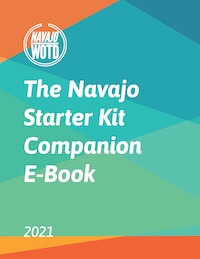nóomba (20-30)
Navajo numbers 20, 21, 22, 23, 24, 25, 26, 27, 28, 29, 30
We’ve given you the sets of numbers leading up to 100 (1-10, 11-20, multiples of 10). Here’s the special set of numbers for the 20-30 range.
- 20 - naadiin
- 21 - naadiin ła’
- 22 - naadiin naakí
- 23 - naadiin táá’
- 24 - naadiin dį́į́’
- 25 - naadiin áshdla’
- 26 - naadiin hast’ą́ą́
- 27 - naadiin tsósts’id
- 28 - naadiin tseebíí
- 29 - naadiin nahast’éí
- 30 - tádiin
This is the third time you’ve seen the word for ‘20’ here on NavajoWOTD. In numbers greater than 30, the case would be tádiin dóó ba’aan t’ááłá’í (31), or another example would be ashdladiin dóó ba’aan ashdla’ (55). So you would essentially form the number by announcing the multiple of 10, adding dóó ba’aan following, and then saying the ones digit.
